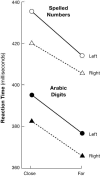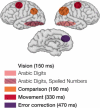Timing the brain: mental chronometry as a tool in neuroscience
- PMID: 15719059
- PMCID: PMC548951
- DOI: 10.1371/journal.pbio.0030051
Timing the brain: mental chronometry as a tool in neuroscience
Abstract
Mental chronometry, which has origins dating back over a century, seeks to measure the time course of mental operations in the human nervous system
Figures


Comment on
-
Parsing a cognitive task: a characterization of the mind's bottleneck.PLoS Biol. 2005 Feb;3(2):e37. doi: 10.1371/journal.pbio.0030037. Epub 2005 Feb 8. PLoS Biol. 2005. PMID: 15719056 Free PMC article.
References
-
- Posner MI. Chronometric explorations of mind. Hillsdale (New Jersey): Lawrence Erlbaum Associates; 1978. 271 pp.
-
- Donders FC. On the speed of mental processes. Acta Psychol. 1969;30:412–431. [Translation of: Die Schnelligkeit psychischer Processe, first published in 1868] - PubMed
-
- Shannon CE, Weaver W. The mathematical theory of communication. Urbana (Illinois): University of Illinois Press; 1949. 117 pp.
-
- Attneave F. Applications of information theory to psychology. New York: Henry Holt; 1959. 120 pp.
-
- Posner MI. Components of skilled performance. Science. 1966;152:1712–1718. - PubMed
Publication types
MeSH terms
LinkOut - more resources
Full Text Sources

